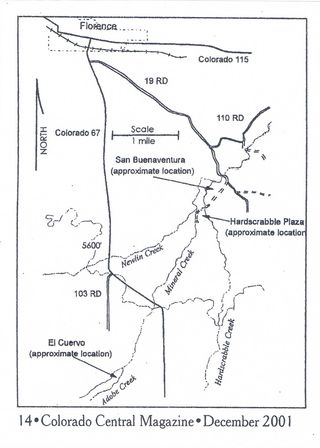A Brief History of the Hardscrabble Area and Wetmore, Colorado
In Custer County, close to the Fremont and Pueblo County lines and located at the junction of State Highways 96 and 67, lies the small village of Wetmore, Colorado. The Hardscrabble area at the foothills of the Wet Mountains is close to the communities of Florence, Canon City, Pueblo and Westcliffe.
The Hardscrabble area has a long and varied history. The Hardscrabble Creek and its tributaries flow north towards Pike's Peak spilling into the Arkansas River at Penrose, making the waterways an important junction of trails. The Hardscrabble was a favorite spot for the early Indian tribes (Ute, Cheyenne, Sioux, Kiowa and Arapaho). Spanish explorers arrived in the 1600’s looking for gold and other riches. French, Mexican, and American trappers, traders and settlers arrived as early as 1830.
Ft. LeDuc was believed to have been built in 1830 by French trappers looking to trade with neighboring Indians, mountain men, and the few Mexican and Anglo settlers in the territory. Ft. LeDuc was located above the junction of Adobe and Mineral Creeks, approximately 9 miles south of the Arkansas River and present day Florence. The fort was named for Maurice LeDuc, one of its founders. It is also known as Buzzard’s Roost, Crow’s Nest, El Cuervo, Ft. LeDeux, and Maurice’s Fort. Today, nothing remains of Ft. LeDuc, and the site is located on private property.
In 1844, several Americans from El Pueblo established a trading post at San Buenaventura de los Tres Arrollos, located about 5 miles northeast of Ft. LeDuc. The name was later changed to Hardscrabble. According to George Simpson, one of its founders, the name came from the “hard scrabbling to get in a crop” in the gravelly soil. Water issues, severe weather, decline in the animal fur trade, and threats from Indian raids soon forced many of the settlers to move away. Ft. LeDuc was closed sometime in the late 1840’s. With the discovery of gold in California in 1849, most of the remaining residents moved west. The area was mostly abandoned when John C. Fremont passed through the Hardscrabble on his 3rd survey expedition looking for a transcontinental railway route in late 1848.
The Homestead Act was passed in 1862 granting 160 acres to anyone who would live on the land and make improvements. American settlers began to move west to the eligible public lands. The settlers came by covered wagon and ox teams. Most were on their way further west, but some settled near the Hardscrabble Creek because of thick, lush grasses and availability of water. By 1870, most of the Indian tribes had been relocated to reservations and much of the land near the Hardscrabble was settled. Public land could not be sold until it was surveyed into townships and sections by the government so the settlers were basically squatters until then. The Wetmore area was surveyed in September and October of 1877 by W. W. Brewster, a contract surveyor. His map shows a school house, blacksmith shop, and stores in the village of Wetmore which was then known as Greenwood Park and or Hardscrabble Park.
On May 13, 1871, a group of settlers organized and built the New Hope Baptist Church northeast of present day Wetmore. There were 110 members at this time. Articles of Incorporation were filed in 1873 by Ira R. Porter, Stephen J. Tanner and William R. Crouch, making it the second oldest Baptist Church in Colorado. The earliest known grave found at the New Hope Cemetery is of Jason P. Vaughn, born November 24, 1869, died February 7, 1870 (2 months and 13 days old).
In 1872, a Post Office was opened in Greenwood and was officially recognized as a Post Office in 1875 with Mr. Monroe acting as Postmaster.
William H. Wetmore (1848-1896) and his wife Francis moved to the area about 1878. William Wetmore was a jack of many trades working as a prospector, Pony Express rider, deputy marshal, clerk, surveyor, rancher-stockman, as well as a correspondent for the Pueblo newspaper. His wife, Francis Wetmore, purchased the 160 acre homestead of William Hayes in December of 1880. Mr. Wetmore surveyed the land, and it is said that he offered lots to anyone who would build on the property and name the township Wetmore. Many settlers took advantage, securing lots from Mrs. Wetmore. No plat of the town has been found so there is no date when the site was actually named Wetmore, but it was some time after the land was purchased in 1880 and prior to April 19, 1881 when the Wetmore Post Office was established with S. H. Callen as Postmaster.
By 1884, the area was well established with a grocery store, general merchandise store and drug store built by Dr. J. W. Walters. Jacob Betts built a two-story building with a saloon downstairs and a dance hall upstairs. There were two blacksmith shops, carpenter shop, hotel (ran by Mary Payne), a schoolhouse, a photographer (J.C. Stoneman), flouring mill built by W.H. Wetmore and a livery stable. The building that was the drug store now houses the Wetmore Post Office and History Center created by the Wetmore-Hardscrabble Genealogical and Historical Society.
In 1895, W.W. Mashburn had a distillery about two miles south of Wetmore, and in 1897 a public hall known as the W.O.W. (Woodman of the World) Hall was built and was quite popular until torn down in the 1940's.
Today, "downtown" Wetmore consists of the Post Office, and History Center, Wetmore Community Church, Wetmore Baptist Church, Wetmore Community Center and Library and the Wetmore General Store Steakhouse.
Sources: Bowers Family History, Peggy A. Martin, Harry Chalfant, Dabney Otis Collins,Pioneer Museum, Pueblo Chieftain and Wetmore Historian Dorothy Breece, A Traveler's Guide to Frontier Pathways, Colorado Central Magazine


















